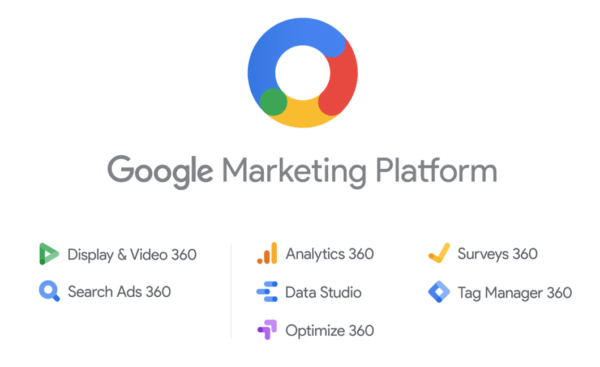 After 18 and 22 years, respectively, the AdWords and DoubleClick brands will soon cease to be. As part of a comprehensive effort to streamline its offerings, Google’s flagship advertising products are getting new names and reorganizing to better reflect their current capabilities and where the company sees trajectories for growth. Along with the rebranding, Google is also introducing some new solutions that further the push toward simplifying its advertising offerings.
After 18 and 22 years, respectively, the AdWords and DoubleClick brands will soon cease to be. As part of a comprehensive effort to streamline its offerings, Google’s flagship advertising products are getting new names and reorganizing to better reflect their current capabilities and where the company sees trajectories for growth. Along with the rebranding, Google is also introducing some new solutions that further the push toward simplifying its advertising offerings.
There will now be three primary brands:
- Google AdWords is now Google Ads.
- DoubleClick advertiser products and Google Analytics 360 Suite are now under the brand Google Marketing Platform.
- DoubleClick for Publishers and DoubleClick Ad Exchange are integrated into a new unified platform called Google Ad Manager.
What’s under the hood of the products largely isn’t changing. Rather these are primarily name changes that are “indicative of where we have been directing products over the last few years,” said Sridhar Ramaswamy, Google’s SVP of ads, at a press briefing Tuesday.
“Consumer expectations from mobile are on the rise…. Opportunity for advertisers is on the rise as well,” said Ramaswamy.
As Google has acquired and developed new ad products, formats and measurement solutions to meet new needs, its offerings have become more complex and numerous over the past two decades. That’s made it harder for advertisers, publishers and agencies to identify and select the right Google products for their needs, Ramaswamy explained. The new branding under three buckets makes the starting point for marketers easier to figure out, and new solutions are aimed at helping marketers achieve better outcomes more easily.
Here’s a look at the new brands and solutions announced Wednesday.
Google Ads

When it launched in 2000 with roughly 350 advertisers, AdWords was a platform for running text ads on desktop Search. Google co-founder and CEO Larry Page said at the time, “AdWords offers the most technologically advanced features available, enabling any advertiser to quickly design a flexible program that best fits its online marketing goals and budget.”
Fast-forward 18 years, and AdWords has evolved into a platform that supports many different ad formats — text, shopping, display, video, app install — across Search, YouTube, Gmail, Maps and a network of partner sites and apps. Millions of advertisers spend billions on the platform annually. It’s outgrown its name.
As Google’s head of ads and commerce, Sridhar Ramaswamy, said of the new branding in an interview with Search Engine Land on Tuesday:
“With Google Ads as opposed to Google AdWords, it is moving the imperceptible default opinion that you get as an advertiser when you hear ‘Google AdWords’ … you think, ‘Oh, Words. Search.’ It’s basically a slight cognitive dissonance to all the other great things that we are doing in terms of both the format and surfaces these ads can show. And so, Google Ads, in our opinion, is a much more straightforward representation of what Google advertising can provide. It’s that simplicity and alignment of the core message from the first instant you hear the name, which is the goal.”
If you’re wondering, as I was, if the AdWords interface that will become the default way advertisers engage with the platform over the next few months came about in anticipation of the rebranding and focus on simplification, it turns out it was more of a coincidence. The UI overhaul really was solely driven by the technology challenges of an eight-year-old framework.
Small businesses continue to present a significant growth opportunity for Google. In furthering the spirit of simplicity, the company announced Smart Campaigns for small businesses who don’t have the time or resources to manage complex digital advertising campaigns. Smart Campaigns rely on machine learning and, like Smart Display Campaigns and Universal App Campaigns, the ad creative, targeting and delivery are largely automated. The campaign type will be the default for new advertisers in Google Ads. For more, see our full coverage on Smart Campaigns.
Google Marketing Platform
For enterprise customers, DoubleClick advertiser products and Analytics 360 now integrated under the umbrella of the Google Marketing Platform to help them plan, buy, measure and optimize digital media buys in one place.
“Marketers have an increasing need to work across teams,” said Dan Taylor, managing director of platforms, “and making that possible is both an organizational and technology challenge.”
The inspiration for unifying DoubleClick and Analytics 360 in one platform came from advertisers who were integrating the two products on their own. Google saw that those advertisers who integrated their analytics with their media platform saw better outcomes.
“We had built integrations between analytics and the creative planning and buying products, but now that will be much easier,” said Taylor. The unification with Analytics 360 means marketers can analyze results, create audiences and activate them without having to navigate a multistep process between two or more products. Within the Google Marketing Platform is a new solution called Display Video 360. It consolidates Google’s enterprise display advertising products: DoubleClick Bid Manager (DBM), media planning and reporting solution DoubleClick Campaign Manager, rich media ad creator tool DoubleClick Studio and data management platform Google Audience Center 360.
Within the Google Marketing Platform is a new solution called Display Video 360. It consolidates Google’s enterprise display advertising products: DoubleClick Bid Manager (DBM), media planning and reporting solution DoubleClick Campaign Manager, rich media ad creator tool DoubleClick Studio and data management platform Google Audience Center 360.
Google’s enterprise-level search management platform, DoubleClick Search, is becoming Search Ads 360.
Google Data Studio, Optimize 360, Surveys 360 and Tag Manager 360 are also part of the Google Marketing Platform.
A new Integration Center explains how the tools work together and to connect them. Marketers can combine Display Video 360 + Analytics 360, Google Ads + Analytics 360, and Analytics 360 + BigQuery quickly in the Integration Center.
Google is often criticized for seeming to favor its own products and integrations. Google Marketing Platform, Taylor stressed, is “designed to offer choice,” with more than 100 existing integrations with ad exchanges, third-party measurement solutions and other products.
Google Marketing Platform will roll out later this month.
Google Ad Manager
The final piece, Google Ad Manager, unifies DoubleClick for Publishers (DFP) and DoubleClick Ad Exchange (AdX). Bringing DFP and AdX together has been a three-year process.
Google beat out Microsoft, Yahoo and AOL to acquire DoubleClick in 2007 for $3.1 billion. It was an ad-serving solution for desktop display ads. Two years later, Google launched DoubleClick Ad Exchange for large publishers to sell advertising inventory in real time.
Now, “marketer demand for addressable advertising has moved us to a place where all buying will be programmatic,” said Jonathan Bellack, director of product management for publisher ad platforms, on Tuesday. That also encompasses programmatic guaranteed and reserved buying.
“That’s why we broke away from the traditional constraints of ‘ad servers’ and ‘SSPs’ [supply-side platforms] to build new programmatic solutions directly into the product we now call Ad Manager — from our programmatic deals framework to features like Optimized Competition that help you maximize yield across reservations, private marketplaces, and the open auction,” Bellack wrote in the announcement.
Also with this change, programmatic and ad network buyers that had been called “AdX buyers” will now be referred to as “Authorized Buyers.”
Google Ad Manager will help publishers monetize all the new places where people are engaging, such as live streams, connected TVs, Accelerated Mobile Pages (AMP), mobile games and other apps, and platforms like YouTube and Apple News, Bellack explained.
What’s next
Marketers will begin to see the branding and solutions roll out starting in mid-July and through the next few months.
I asked Ramaswamy about how these changes position the company for the future and where he sees opportunity. For a company that already dominates the digital advertising market, Ramaswamy still sees lots of runway ahead for YouTube, apps, Gmail, Image Search and the Google feed, among other areas.
“Advertising is very nascent on YouTube,” he said, “We have a set of formats but I think there is so much more we can do for things like direct response.”
“The combination of the four major areas — mobile Search, YouTube, app install ads and programmatic ads — all have more than done their part” to drive growth for Google in the mobile era, said Ramaswamy.
The new branding and solutions are aimed at freeing up advertisers to focus more on improving outcomes and less on product selection to keep the momentum going for the next 20+ years.
Want more info on Paid Search? Check out our comprehensive PPC Guide – 9 chapters covering everything from account setup to automation and bid adjustments!

